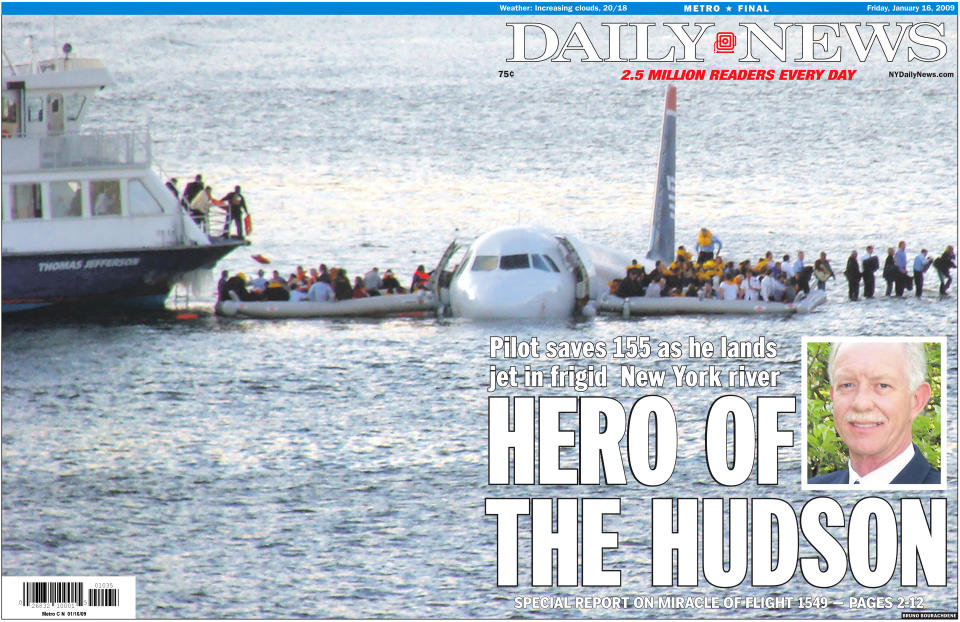Captain 'Sully' Sullenberger has a message for Boeing about its 737 Max
Chesley “Sully” Sullenberger, the decorated commercial airline captain responsible for saving the lives of 155 people in a heroic 2009 landing on New York’s Hudson River, has a message for Boeing (BA) and the Federal Aviation Administration: pilots need robust training before the 737 Max returns to the skies.
“Reading about it on an iPad isn't even close to sufficient,” Sullenberger testified during a congressional subcommittee hearing on Wednesday. He asserted that recertification should require simulator training, which subjects pilots to conditions that closely emulate those in flight.
“We should all want pilots to experience these challenging situations for the first time in a simulator and not in flight with passengers and crew on board,” Sullenberger said.
More time and costs before the Max can fly?
Exactly how much and what type of pilot training is needed before Boeing’s Max can be re-certified by the FAA and returned to service has been a topic of debate, as some aviation experts point to a lack of sufficient training concerning the Max systems as a central cause in the cascade of events that led to two fatal Max aircraft crashes within five months. Meanwhile, others claim more experienced pilots would have averted crisis. Simulator training, estimated to cost hundreds of dollars per hour, if required by the FAA, will add time and cost to the Max’s return to flight.
“We must face [the emergency] first-hand in a simulator before we experience it in flight,” Sullenberger told lawmakers.
As a result of the crashes, Boeing agreed to modify all Max planes in order to feed additional sensor data into a system designed for the aircraft called MCAS, or Maneuvering Characteristics Augmentation System. The system, which automatically pushes the nose of the plane down to prevent engine stall, is known to have been activated in both the Lion Air and Ethiopian Airlines crashes that killed all passengers and crew on board.

The importance of the ‘startle factor’
Throughout his testimony, Sullenberger emphasized the significance of pilot “startle factor” and chaotic cockpit situations that play into a pilot’s emergency response capabilities.
Asked by Rep. Thomas Massie (R-KY) whether more experienced pilots would have been able to handle the MCAS-related emergencies, Sullenberger opined that it would have been unlikely they would have performed differently than the crews on the accident flights.
“I'm one of a relatively small group of people who have experienced such a crisis and lived to share what we learned about it. I can tell you firsthand that the startle factor is real. And it's huge. It absolutely interferes with one's ability to quickly analyze the crisis and take an active action,” Sullenberger said. “In both 737 max accidents, the failure of a single angle of attack sensor quickly caused multiple instrument indication anomalies, and sudden, loud, and in some cases, false warnings, creating major distractions masking the cause, and would have made it even harder to quickly analyze the situation and take effective, corrective action.”
Captain Dan Carey, Allied Pilots Association president and veteran commercial aircraft pilot, seconded Sullenberg’s position.
“This is a sudden, violent, and terrifying event,” Carey testified. “So airplanes pitching up and down rapidly and violently. There's bells, warnings, and clappers sounding. Communication is difficult.”
Carey blamed Boeing for prioritizing costs over safety.
“The Max was designed to provide the same aircraft feel as the 737. This was intended to minimize costs to Boeing's customers by allowing the Max to be certified as a 737-type aircraft. This led Boeing engineers to add the MCAS system,” he said. “Boeing failed to disclose the existence of the MCAS system to the pilot community around the world. The final fatal mistake was therefore the absence of a robust pilot training in the event of an MCAS failure.”
Boeing CEO Dennis Muilenburg has suggested a less aggressive approach than simulator training.
“We believe that the right answer right now is computer-based training,” Muilenberg told shareholders during Boeing’s annual meeting in April. “And then as part of the recurring training that pilots might do downstream, give them options for simulator training.”
Ultimately, the decision on requisite training rests with FAA regulators.
In response to whether Boeing’s position on flight training had changed since Muilenberg’s statement in April, a company spokesperson told Yahoo Finance, “Boeing continues to work with global regulators and our airline customers as they determine training requirements.”
Regarding the timeline for the Max to return to service, Boeing’s spokesperson said, “We have not given a timeline — safety is our priority and is the primary driver in the process. We have finalized the software update and the next step will be to finish certification work in the simulators ahead of the certification test flights, which will be scheduled with the FAA.”
Read more:
‘These kids never consented’: Why Amazon is being sued over Alexa recordings
Why the media is blaming Facebook and Google for its decline
‘The full Willy Wonky Tour’: Inside Weed company Cresco’s production house
GOP Senator has ‘pretty good confidence’ Congress will pass weed legislation
These are the biggest threats to the cannabis industry, according to top CEOs in the space
Why the world’s largest marijuana company is doubling its plans for US hemp
Alexis Keenan is a New York-based reporter for Yahoo Finance. She previously produced and reported for CNN and is a former litigation attorney. Follow on Twitter @alexiskweed.
Follow Yahoo Finance on Twitter, Facebook, Instagram, Flipboard, SmartNews, LinkedIn,YouTube, and reddit.
